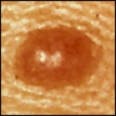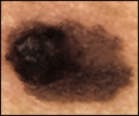Early detection is vital in dealing with melanoma
By Maria Perno Goldie, RDH, MS
More young adults , particularly young women, are developing melanoma, the most dangerous form of skin cancer. But the odds of surviving melanoma have improved over time, according to a new study.(1) The study, which spanned four decades, found that the incidence of cutaneous melanoma rose by a factor of more than six from 1970-1979 through 2000-2009. Conversely, the risk of dying from melanoma fell by nine percent per year over the same period. Research based on the CDC's Surveillance Epidemiology and End Results (SEER) database corroborate this, and has shown that national melanoma rates have been rising, while survival has been improving, the researchers noted.(2) The rise in tanning bed behavior over the years is probably a major contributor, according to the study authors. Current estimates are that one in five Americans will develop skin cancer.(3) More than 3.5 million new cases of skin cancer will be diagnosed in the United States this year. Of these cases, it is estimated that about 131,810 are melanoma, the deadliest form of skin cancer, which claims an estimated 9,180 lives annually. One American dies of melanoma almost every hour. (American Cancer Society. Cancer Facts & Figures 2010.(4) The five-year survival rate for people whose melanoma is detected and treated before it metastasizes to the lymph nodes is 98%. You can prevent and detect skin cancer. Prevent skin cancer. Seek shade, cover up, wear sunscreen, and avoid tanning beds. Sun exposure is the most preventable risk factor for all skin cancers, including melanoma.(5,6) You can enjoy the sun and decrease your risk of skin cancer. Here's how you can prevent skin cancer: Seek shade when appropriate. Remember that the sun’s rays are strongest between 10 a.m. and 2 p.m. If your shadow appears to be shorter than you are, seek shade. Wear protective clothing, such as a long-sleeved shirt, pants, a wide-brimmed hat, and sunglasses, where possible. Generously apply a broad-spectrum, water-resistant sunscreen with a Sun Protection Factor (SPF) of 30 or more to all exposed skin. “Broad-spectrum” provides protection from both ultraviolet A (UVA) and ultraviolet B (UVB) rays. Reapply approximately every two hours, even on cloudy days, and after swimming or sweating. Use extra caution near water, snow, and sand because they reflect and intensify the damaging rays of the sun, which can increase your chances of sunburn. Avoid tanning beds. Ultraviolet light from the sun and tanning beds can cause skin cancer and wrinkling. If you want to look tan, consider using a self-tanning product or spray, but continue to use sunscreen with it.
More young adults , particularly young women, are developing melanoma, the most dangerous form of skin cancer. But the odds of surviving melanoma have improved over time, according to a new study.(1) The study, which spanned four decades, found that the incidence of cutaneous melanoma rose by a factor of more than six from 1970-1979 through 2000-2009. Conversely, the risk of dying from melanoma fell by nine percent per year over the same period. Research based on the CDC's Surveillance Epidemiology and End Results (SEER) database corroborate this, and has shown that national melanoma rates have been rising, while survival has been improving, the researchers noted.(2) The rise in tanning bed behavior over the years is probably a major contributor, according to the study authors. Current estimates are that one in five Americans will develop skin cancer.(3) More than 3.5 million new cases of skin cancer will be diagnosed in the United States this year. Of these cases, it is estimated that about 131,810 are melanoma, the deadliest form of skin cancer, which claims an estimated 9,180 lives annually. One American dies of melanoma almost every hour. (American Cancer Society. Cancer Facts & Figures 2010.(4) The five-year survival rate for people whose melanoma is detected and treated before it metastasizes to the lymph nodes is 98%. You can prevent and detect skin cancer. Prevent skin cancer. Seek shade, cover up, wear sunscreen, and avoid tanning beds. Sun exposure is the most preventable risk factor for all skin cancers, including melanoma.(5,6) You can enjoy the sun and decrease your risk of skin cancer. Here's how you can prevent skin cancer: Seek shade when appropriate. Remember that the sun’s rays are strongest between 10 a.m. and 2 p.m. If your shadow appears to be shorter than you are, seek shade. Wear protective clothing, such as a long-sleeved shirt, pants, a wide-brimmed hat, and sunglasses, where possible. Generously apply a broad-spectrum, water-resistant sunscreen with a Sun Protection Factor (SPF) of 30 or more to all exposed skin. “Broad-spectrum” provides protection from both ultraviolet A (UVA) and ultraviolet B (UVB) rays. Reapply approximately every two hours, even on cloudy days, and after swimming or sweating. Use extra caution near water, snow, and sand because they reflect and intensify the damaging rays of the sun, which can increase your chances of sunburn. Avoid tanning beds. Ultraviolet light from the sun and tanning beds can cause skin cancer and wrinkling. If you want to look tan, consider using a self-tanning product or spray, but continue to use sunscreen with it.
www.cancer.org/acs/groups/content/@epidemiologysurveilance/documents/document/acspc-029771.pdfFigure 1
Detect skin cancer. Look for new or changing spots on your skin. The first line of defense against skin cancer starts with the individual. Ask a dermatologist how often you should examine your skin for signs of skin cancer and consult a dermatologist if you notice anything suspicious. These simple steps can help ensure that skin cancer is diagnosed in its earliest, most treatable stage. Resources available are: How to perform a self exam (7); body mole map; and what to look for, The ABCDEs of melanoma (8). Record your spots during your next skin self-exam. Know the warning signs of melanoma! The ABCDEs of melanoma(8)
Asymmetry
Asymmetry can be assessed by comparing one half of the growth to the other half to determine if the halves are equal in size. Unequal or asymmetric moles are suspicious.
Detect skin cancer. Look for new or changing spots on your skin. The first line of defense against skin cancer starts with the individual. Ask a dermatologist how often you should examine your skin for signs of skin cancer and consult a dermatologist if you notice anything suspicious. These simple steps can help ensure that skin cancer is diagnosed in its earliest, most treatable stage. Resources available are: How to perform a self exam (7); body mole map; and what to look for, The ABCDEs of melanoma (8). Record your spots during your next skin self-exam. Know the warning signs of melanoma! The ABCDEs of melanoma(8)
Asymmetry
Asymmetry can be assessed by comparing one half of the growth to the other half to determine if the halves are equal in size. Unequal or asymmetric moles are suspicious.
Symmetric (normal) and Asymmetric
Border
If the mole's border is irregular, notched, scalloped, or indistinct, it is more likely to be cancerous (or precancerous) and is thus suspicious.
Border
If the mole's border is irregular, notched, scalloped, or indistinct, it is more likely to be cancerous (or precancerous) and is thus suspicious.
Regular Border (normal) and Irregular Border
Color
Variation of color (e.g., more than one color or shade) within a mole is a suspicious finding. Different shades of browns, blues, reds, whites, and blacks are all concerning.
Color
Variation of color (e.g., more than one color or shade) within a mole is a suspicious finding. Different shades of browns, blues, reds, whites, and blacks are all concerning.
One Color (normal) and Color Variance
Diameter
Any mole that has a diameter larger than a pencil's eraser in size (> 6 mm) should be considered suspicious.
Diameter
Any mole that has a diameter larger than a pencil's eraser in size (> 6 mm) should be considered suspicious.
Elevation
If a mole is elevated, or raised from of the skin, it should be considered suspicious.See a dermatologist if you spot anything changing, itching, or bleeding.
Doing a little research can help to detect a skin cancer, the most common form of cancer diagnosed in the United States, at its earliest, most treatable stage. However, a new survey found that many people do not know how to spot skin cancer and are unaware of their risk of developing the disease. In an effort to increase the public’s understanding of skin cancer and motivate people to change their behavior to prevent and detect skin cancer, the American Academy of Dermatology (Academy) launched the new SPOT Skin Cancer public awareness initiative on May 7, 2012.(9) The campaign’s simple tagline is: “Prevent. Detect. Live.” It highlights the positive measures people can take to protect themselves from skin cancer, including seeing a dermatologist when appropriate. Skin cancer shows obvious signs on the surface of the skin that can be easily detected by properly examining it, unlike some other types of cancer. The goal of SPOT Skin Cancer is to help save lives by educating the public on how to protect themselves from the sun and how to examine their skin for suspicious spots.Survey Statistics
The need for a comprehensive skin cancer resource is evident based on the public’s general lack of understanding of detecting and preventing skin cancer. In fact, the Academy conducted an online survey of adults nationwide which showed: • Almost three-quarters of respondents (74 percent) did not know that skin cancer is the most common form of cancer in the U.S. • Only half (53 percent) of respondents knew how to examine their skin for signs of skin cancer. • Thirty percent of respondents were either unsure or did not know that skin cancer can be easily treated when caught early.Skin Cancer Facts
• More than 3.5 million skin cancer cases affecting 2 million people are diagnosed annually. • Current estimates are that one in five Americans will be diagnosed with skin cancer in their lifetime. • The five-year survival rate for people whose melanoma (the deadliest form of skin cancer) is detected and treated before it spreads to the lymph nodes is 98 percent. The SPOT Skin Cancer program’s new website is where visitors can learn how to perform a skin self-exam, download a body mole map for tracking changes in your skin, and find free skin cancer screenings in their area. Those affected by skin cancer also will be able to share their story via the website and download free materials to educate others in their community. Spanish resources are also available.(10) In closing, should you be diagnosed with melanoma, see a dermatologist. “Guidelines of care for the management of primary cutaneous melanoma” are available.(11) Based on an extensive review of scientific literature and the recommendations of recognized melanoma experts, the American Academy of Dermatology (Academy) released these updated evidence-based guidelines for the treatment of melanoma in 2011. Remember, there are four types of melanoma: Superficial spreading melanoma (about 70% of diagnosed cases); Nodular melanoma (about 15% of diagnosed cases); Lentigo maligna melanoma (about 10% of diagnosed cases); Acral lentiginous .melanoma (about 5% of diagnosed cases).(12) Also, look for “hidden” melanomas: Nail Bed (underneath the nail); Mucosal Tissue (tissue lining the nose, mouth, female genitals, anus, urinary tract, and esophagus); Scalp; and Eye (eyelid or pigmented coating of the eyeball). As dental hygienists and dentists we can be on the lookout for suspicious lesions when we perform our oral cancer examinations, and when we are working on our patients. Melanoma is a serious public health issue, and as with any disease, prevention and early detection are vital to positive outcomes and survival. References
1. Reed KB, et al "Increasing incidence of melanoma among young adults: an epidemiologic study in Olmsted County, Minnesota" Mayo Clin Proceed 2012; DOI: 10.1016/j.mayocp.2012.01.010. 2. seer.cancer.gov/statfacts/html/melan.html. Accessed May 26, 2012. 3. www.skincancer.org/skin-cancer-information/skin-cancer-facts. Accessed May 26, 2012. 4. www.cancer.org/research/cancerfactsfigures/cancerfactsfigures/cancer-facts-and-figures-2010. Accessed May 26, 2012. 5. American Cancer Society. Cancer Facts and Figures 2011. www.cancer.org/acs/groups/content/@epidemiologysurveilance/documents/document/acspc-029771.pdf. Accessed May 26, 2012. 6. Robinson, JK. Sun Exposure, Sun Protection and Vitamin D. JAMA 2005; 294: 1541-43. 7. www.aad.org/spot-skin-cancer/understanding-skin-cancer/how-do-i-check-my-skin/how-to-perform-a-self-exam/how-to-perform-a-self-exam. Accessed May 26, 2012. 8. The ABCDEs of melanoma (www.afraidtoask.com/skinCA/skinwarning.html. Accessed May 26, 2012. 9. www.aad.org/spot-skin-cancer. Accessed May 26, 2012. 10. www.aad.org/spot-skin-cancer/understanding-skin-cancer/spanish-resources. Accessed May 26, 2012. 11. www.aad.org/File%20Library/Global%20navigation/Education%20and%20quality%20care/guidelines-of-care-melanoma.pdf. Accessed May 26, 2012. 12. www.skincarephysicians.com/skincancernet/four_types.html. Accessed May 26, 2012.
If a mole is elevated, or raised from of the skin, it should be considered suspicious.See a dermatologist if you spot anything changing, itching, or bleeding.
Doing a little research can help to detect a skin cancer, the most common form of cancer diagnosed in the United States, at its earliest, most treatable stage. However, a new survey found that many people do not know how to spot skin cancer and are unaware of their risk of developing the disease. In an effort to increase the public’s understanding of skin cancer and motivate people to change their behavior to prevent and detect skin cancer, the American Academy of Dermatology (Academy) launched the new SPOT Skin Cancer public awareness initiative on May 7, 2012.(9) The campaign’s simple tagline is: “Prevent. Detect. Live.” It highlights the positive measures people can take to protect themselves from skin cancer, including seeing a dermatologist when appropriate. Skin cancer shows obvious signs on the surface of the skin that can be easily detected by properly examining it, unlike some other types of cancer. The goal of SPOT Skin Cancer is to help save lives by educating the public on how to protect themselves from the sun and how to examine their skin for suspicious spots.Survey Statistics
The need for a comprehensive skin cancer resource is evident based on the public’s general lack of understanding of detecting and preventing skin cancer. In fact, the Academy conducted an online survey of adults nationwide which showed: • Almost three-quarters of respondents (74 percent) did not know that skin cancer is the most common form of cancer in the U.S. • Only half (53 percent) of respondents knew how to examine their skin for signs of skin cancer. • Thirty percent of respondents were either unsure or did not know that skin cancer can be easily treated when caught early.Skin Cancer Facts
• More than 3.5 million skin cancer cases affecting 2 million people are diagnosed annually. • Current estimates are that one in five Americans will be diagnosed with skin cancer in their lifetime. • The five-year survival rate for people whose melanoma (the deadliest form of skin cancer) is detected and treated before it spreads to the lymph nodes is 98 percent. The SPOT Skin Cancer program’s new website is where visitors can learn how to perform a skin self-exam, download a body mole map for tracking changes in your skin, and find free skin cancer screenings in their area. Those affected by skin cancer also will be able to share their story via the website and download free materials to educate others in their community. Spanish resources are also available.(10) In closing, should you be diagnosed with melanoma, see a dermatologist. “Guidelines of care for the management of primary cutaneous melanoma” are available.(11) Based on an extensive review of scientific literature and the recommendations of recognized melanoma experts, the American Academy of Dermatology (Academy) released these updated evidence-based guidelines for the treatment of melanoma in 2011. Remember, there are four types of melanoma: Superficial spreading melanoma (about 70% of diagnosed cases); Nodular melanoma (about 15% of diagnosed cases); Lentigo maligna melanoma (about 10% of diagnosed cases); Acral lentiginous .melanoma (about 5% of diagnosed cases).(12) Also, look for “hidden” melanomas: Nail Bed (underneath the nail); Mucosal Tissue (tissue lining the nose, mouth, female genitals, anus, urinary tract, and esophagus); Scalp; and Eye (eyelid or pigmented coating of the eyeball). As dental hygienists and dentists we can be on the lookout for suspicious lesions when we perform our oral cancer examinations, and when we are working on our patients. Melanoma is a serious public health issue, and as with any disease, prevention and early detection are vital to positive outcomes and survival. References
1. Reed KB, et al "Increasing incidence of melanoma among young adults: an epidemiologic study in Olmsted County, Minnesota" Mayo Clin Proceed 2012; DOI: 10.1016/j.mayocp.2012.01.010. 2. seer.cancer.gov/statfacts/html/melan.html. Accessed May 26, 2012. 3. www.skincancer.org/skin-cancer-information/skin-cancer-facts. Accessed May 26, 2012. 4. www.cancer.org/research/cancerfactsfigures/cancerfactsfigures/cancer-facts-and-figures-2010. Accessed May 26, 2012. 5. American Cancer Society. Cancer Facts and Figures 2011. www.cancer.org/acs/groups/content/@epidemiologysurveilance/documents/document/acspc-029771.pdf. Accessed May 26, 2012. 6. Robinson, JK. Sun Exposure, Sun Protection and Vitamin D. JAMA 2005; 294: 1541-43. 7. www.aad.org/spot-skin-cancer/understanding-skin-cancer/how-do-i-check-my-skin/how-to-perform-a-self-exam/how-to-perform-a-self-exam. Accessed May 26, 2012. 8. The ABCDEs of melanoma (www.afraidtoask.com/skinCA/skinwarning.html. Accessed May 26, 2012. 9. www.aad.org/spot-skin-cancer. Accessed May 26, 2012. 10. www.aad.org/spot-skin-cancer/understanding-skin-cancer/spanish-resources. Accessed May 26, 2012. 11. www.aad.org/File%20Library/Global%20navigation/Education%20and%20quality%20care/guidelines-of-care-melanoma.pdf. Accessed May 26, 2012. 12. www.skincarephysicians.com/skincancernet/four_types.html. Accessed May 26, 2012.
Maria Perno Goldie, RDH, MS
To read previous articles in RDH eVillage FOCUS written by Maria Perno Goldie, go to articles.





